The Goldfish are one of the most popular pet fish options, and they were the first species of fish to be kept as pets in Asia centuries ago. Despite their name, Types of goldfish come in a broad range of colors, as well as fancy fin and tail forms.
The Goldie (Carassius auratus) is a freshwater fish of the Cyprinidae family. They are East Asian freshwater fish that have been selectively bred for over 1,000 years.
They come in a variety of sizes and may thrive in a home aquarium or a pond in your backyard garden. There are currently over 300 various types of goldfish, albeit many of them are merely variants of other basic types.
Here are Top popular 20 types of goldfish you should know about:
Contents Overview
Top Six Types of Hardy, Single-finned Goldfish
Common Goldfish
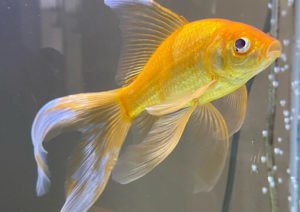
The common goldfish has a slim body, a single tail, and no special features. They are usually cheap and are offered as “feeder fish” for predatory fish.
In comparison to other types of goldfish, they have a small tail and a short body. Common Goldfish may thrive in a home aquarium or a filtered pond. This common goldie is unusual in that it lives and sleeps with its eyes closed.
This Common Goldie are the most inexpensive species of goldfish and are easily obtainable at pet stores and through breeders. They are a good choice for beginner fishermen.
Breed Overview
- Color: Solid or a mix of any: Orange, red, blue, black, or brown
- Patterns: Bi-colored
- Size: 4 to 14 inches
- Tank Size: 10 gallons for juvenile, 20 gallons for adult; add 10-15 gallons for each adult
- Care level: Easy
Comet Goldfish

Comets goldfish were first recognized in the United States in the 1880s. Since then, they’ve prevailed among single-tail goldfish. They are quick swimmers, as their names imply. Comet may require more space because of their long tails.
This goldfish have a slightly shorter, slimmer body than Common goldfish, but they have a distinct broad, long tail with sharp tips. These goldfish are lively and handsome, and they are the most famous goldfish breeds!
They are cold-water fish that thrive in ponds, but they may be kept in warm aquariums. Comets are usually brightly colored; having a striking red or orange color that looked amazing in a pond.
Breed Overview
- Color: Red/orange, white, yellow, green, or chocolate
- Patterns: Bi-colored
- Size: up to 12 inches
- Tank Size: 15 gallons for the juvenile; 30 gallons for adult, Add 15 to 20 gallons per adult
- Care level: Easy
Jikin Goldfish
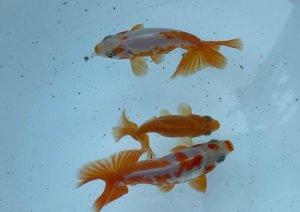
Jikin goldfish, usually recognized as “peacock goldfish,” have the body form of a Wakin goldfish but might have a shoulder hump like a Ryukin goldfish.
This goldfish are a unique breed that is chosen solely for their visual appeal. They are long, thin, and common despite being double-tailed, with their flowing tail presenting an “X” shape when viewed from behind.
They are less hardy goldfish that require a heater but may thrive in ponds if the conditions are perfect. In Japan, the Jikin goldfish is regarded as a national treasure.
Breed Overview
- Color: Red and white. White body with deep crimson on lips, gill covers
- Patterns: Bi-colored
- Size: 10 to 12 inches
- Tank size: 30 gallons
- Care level: Easy to moderate
Shubunkin Goldfish
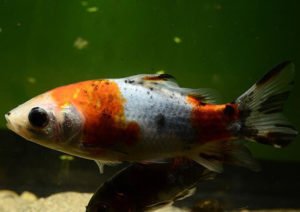
In Japanese, shubunkin means “red brocade.” They’re also known as “calico goldfish.” These slim-bodied, single-tail goldfish are recognized by their calico color.
They feature a long body, a single flowing tail, and flowing fins. They may live in aquariums and also ponds. Shubunkin comes in three varieties: American, Bristol, and London.
The tails of Americans are lengthy and feature deep indentations. Bristols’ tails are circular and lobed, forming the letter “B.” Londons have shorter, rounder tails than commons.
Shubunkins, like goldfish, can tolerate a wide range of temperatures. They’re also hardy, yet they might be finicky about their food.
Breed Overview
- Color: blue with white, black, or red/orange patches or speckles
- Patterns: Calico
- Size: 2 to 4 inches for juveniles; 10 to 12 inches at maturity
- Tank Size: 10 gallons for the juvenile; 20 gallons for adult, Add 10 to 15 gallons per adult
- Care level: Easy
Wakin Goldfish
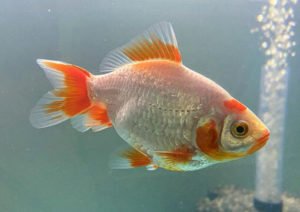
The wakin goldfish is a fancy Japanese variant of the common goldfish that is a popular option for garden ponds. This is a typical fish with a vivid splash of color.
This fancy goldfish is said to be a hybrid among a Comet and a Fantail goldfish. The Wakin’s body is long and sleek, with an upright dorsal fin that extends all the way down the back.
This type of goldfish are distinguished as a fancy breed by their paired caudal and anal fins, as well as their long, thin bodies, which are similar to single-tailed goldfish.
This unique breed of fancy goldfish is quite easy to care for and may thrive in a big aquarium, but they are probably best suited to pond life.
Breed Overview
- Color: Red, orange, calico, black
- Patterns: Single-colored, bi-colored
- Size: 10 to 12 inches
- Tank size: 50 gallons
- Care level: Easy to moderate
Watonai Goldfish
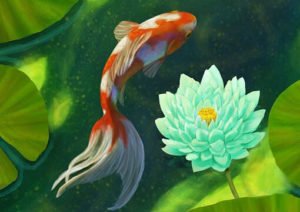
Watonais is said to be a hybrid among the Wakin goldfish and the Comet goldfish, but it could also be a cross between the Wakin and the fancy Ryukin goldfish.
This type of goldfish is another cross with a long double tail that is very similar to the Wakin. The Watonai is an extremely rare type of fancy double tail goldfish.
The watonai was bred from both the wakin and ryukin goldfish. They have tails that are longer and trailing than Wakins’. This combo was so stunning that it was hard to forget.
Breed Overview
- Color: Red, orange, calico, black
- Patterns: Single-colored, bi-colored
- Size: 10 to 12 inches
- Tank size: 50 gallons
- Care level: Easy to moderate
Top 14 Types of Fancy Goldfish
Oranda Goldfish
Oranda goldfish are the most popular type of fancy goldfish. The oranda fish is also known as the Red Cap for its unique red-colored head.
This species is believed to be a crossbred species that has developed over hundreds of years; some believe it has existed since the 15th century.
They get along well with other peaceful fancies. These goldfish have a delicate, textured growth on their heads called a wen. This wen grows in size as the fish grows older.
Orandas do better in ponds than in aquariums so they are large fish that require a huge tank if kept inside.
Breed Overview
- Color: Red, white, chocolate, gold, black, blue, calico
- Patterns: Single-colored, bi-colored
- Size: 7 to 9 inches
- Minimum tank size: 20 gallons
- Care level: Moderate to difficult
Ryukin Goldfish
Ryukin fancy goldfish are directly descended from Fantails. The Ryukin goldfish has a unique form that like a hunchback. The fish is large and round, with a fancy tail and dorsal fins.
This goldfish is a descendent of the fantail goldfish, or was developed from that species in first instance. They are known to be aggressive with other fish, notably shubunkin and comet goldfish.
Ryukins are one of the easier exotic kinds to care for, and they may thrive in an outdoor pond setting. It flourishes in ponds if the ideal warmer temperature remains using a heater.
Breed Overview
- Color: orange, yellow, white, black, red
- Patterns: Single-colored, bi-colored, calico, koi
- Size: 6 to 10 inches
- Tank size: 30 gallons
- Care level: Easy to moderate
Telescope Eye Goldfish
Telescope goldfish are one of the most popular fancy breeds. They are believed to have originated in China, but are currently bred all over the world. Their large, projecting eyes set them apart. They might have round, cone-shaped, or tube-shaped eyes.
These fish can adapt to cooler temperatures and a variety of conditions, making it a popular option. These fish resemble Fantails but are smaller.
These types of goldfish can be quite fragile, which is why you should take care to prevent hoses and possibly sharp things in the tank. Because of its poor eyesight and the risk of eye injury, this goldfish is not a good choice for a pond.
Breed Overview
- Color: Red, orange, white, chocolate, gold, black, blue, calico
- Patterns: Single-colored, bi-colored
- Size: 7 to 9 inches
- Tank size: 20 gallons
- Care level: Moderate to difficult
Fantail Goldfish
Fantail goldfish are probably the most common type of fancy goldfish. They have the typical fancy goldfish egg form, a longer rear fin, and a long and flowy tail.
Their title suggests their obvious tail form, yet their coloring is extremely similar to the “classic” goldfish look. A fantail goldfish is an excellent option for a beginner’s first fancy fish.
Fantails are a kind of double-tail goldfish that are harder to care for than normal goldfish but are perfect for beginners. Many people consider the fantail goldfish to be the European version of the Ryukin goldfish.
Fantails are the most popular type of fancy goldfish. These fish have been around for a long time and have a loyal following among fish keepers.
Breed Overview
- Color: orange, yellow, white, black, red
- Patterns: Single-colored, bi-colored, calico, koi
- Size: 6 to 8 inches
- Tank size: 20 gallons
- Care level: Easy to moderate
Celestial Eye Goldfish
Celestial eye goldfish have been around since the 18th century and can make for a very interesting addition to the home aquarium. Also known as the stargazer, celestial eye goldfish take the telescope goldfish plan and mutate it further.
This goldfish looks like something from Mars. It is a very peculiar and interesting species with eyes that seem to be staring at the stars.
Celestial is a super unique breed that many people love. Celestials may live in either a tank or a pond, but because of their poor vision, they prefer to live in a tank.
Celestials need an aquarium that isn’t too bright, and definitely need their light off at night so they can sleep. They are sensitive to their water quality than other breeds and prone to health problems.
Breed Overview
- Color: Red, orange, calico, black
- Patterns: Single-colored, calico
- Size: 4 to 6 inches
- Tank size: 20 gallons
- Care level: Extremely difficult
Ranchu Goldfish
The ranchu goldfish is certainly a wonderful sight. This types of goldfish is shown to have developed in China and has been there for centuries; it also arrived in Japan in the 19th century and has spread worldwide.
This types of goldfish has a very distinctive look. When it comes to the head and body dispositions, it is similar to the Lionhead goldfish. They have a wen that develops and can block vision as they grow.
Their tail is unusual since it is short yet fans out to the sides. These fish are well-known for their living creature and cleverness. Indeed, these fish can range from house pets to show-quality fish.
Ranchu are also known as the “king of the goldfish” in Japan due to their high value. This goldfish flourish in an air-temp tank with other goldfish of the same species.
Breed Overview
- Color: Red, white, gold, black, yellow
- Patterns: Single-colored, bi-colored
- Size: 5 to 8 inches
- Tank size: 20 gallons
- Care level: Difficult
Veiltail Goldfish
The Veiltail is a gorgeous goldfish that several owners adore. These are the first that spring to mind When the thinking about “fancy” goldfish. The veiltail is a beautiful fish, perhaps one of the most attractive varieties of goldfish.
They are unable to seek food, thus they thrive on floating food. They can be kept among other delicate fancies such as Bubble Eyes. It has an egg-shaped body and a beautiful array of fins, making it both unusual and beautiful.
This type is recognized by its very long and flowing fins, which hang and trail behind them as they swim. The Veiltail swims slowly around the tank due to its fins. It appears that their fins are double the size of their body!
Breed Overview
- Color: Orange, white, red
- Patterns: Single-colored, bi-colored
- Size: 7 to 8 inches
- Tank size: 20 gallons
- Care level: Moderate to difficult
Black Moor Goldfish
The black moor is a fantail goldfish that is either completely black or mostly black with some bronze patches on its fin tips and belly. Except for their underbellies, these fish are entirely black.
The Japanese name black moors “Kuro demekin,” and the Chinese call them “dragon eye.” The black moor types of goldfish is proof that goldfish do not have to be gold!
The black moor is a type of telescope eye goldfish with largely or fully black scales. The more black coverage the moor has the higher the perceived quality of the fish.
Black moor goldfish are slow and graceful swimmers with trailing fins identical to other goldfish. These fish may be kept in ponds, but they must be kept in warm water.
Breed Overview
- Color: Black
- Patterns: Single-colored
- Size: 7 to 9 inches
- Tank size: 20 gallons
- Care level: Moderate to difficult
Lionhead Goldfish
The Lionhead goldfish is native to China and is quite popular among hobbyists. It has an egg-shaped rounded body, a twin fan-shaped tail, and no dorsal fin. This goldfish was a precursor of the Ranchu and has a body shape similar to a wen.
The stunning Lionhead goldfish is the most popular pet of dorsal-less goldfish. These exotic fish are like Ranchu have a flatter back and the classic double tail. Because of their modest swimming rates, they have a peaceful attitude.
Lionheads are slow and should be kept in hot tanks with other slow tankmates. They may live in either a tank or a pond, but they require a large fish tank to flourish.
Breed Overview
- Color: Red, orange, white, chocolate, gold, black, blue, calico
- Patterns: Single-colored, bi-colored
- Size: 5 to 8 inches
- Tank size: 20 gallons
- Care level: Difficult
Bubble Eye Goldfish
Goldfish with bubble eyes are easily recognized. Bubble Eye goldfish originated in Asia, so it became popular in the western world after World War II. The water-filled sacs appear around six months and grow alongside the fish.
This type of goldfish is the most unusual looking because it has large bags of flesh under its eyes that are filled with water. These bags resemble bubbles and can actually grow enough to obscure the goldfish’s vision.
Bubble Eye goldfish are fragile, slow swimmers that should not be kept in ponds. Because these fish require special care, they aren’t usually the best choice for beginners.
Breed Overview
- Color: Red, blue, white, calico, black
- Patterns: Single-colored, bi-colored, tri-colored
- Size: 4 to 6 inches
- Tank size: 20 gallons
- Care level: Difficult
Butterfly Tail Goldfish
Butterfly tail goldfish may be kept in ponds and have other distinct qualities such as telescopic eyes or hoods. These types of goldfish are popular amongst breeders right now, and they come in a wide range of scale types, patterns, and colors.
These are some of the most elegant-looking fish around. This is a telescope goldfish that has been bred to have two large, fan-shaped tails that look like butterfly wings.
The Butterfly Tail is a goldfish variety that has been genetically bred, and the results are amazing. The long, flowing tails of these slow-moving goldfish resemble butterflies above them.
One of the most delicate goldfish species is the Butterfly Tail goldfish. Other unusual features of butterfly tail goldfish include hoods and telescopic eyes.
Breed Overview
- Color: Black, white, red
- Patterns: Single-colored, bi-colored, tri-colored, calico, panda
- Size: 7 to 8 inches
- Tank size: 20 gallons
- Care level: Moderate to difficult
Pompom Goldfish
Pompom goldfish, also known as Pompon goldfish in Japan, lack a dorsal fin and are recognized by small, fleshy growths between their noses.
This fish has a body shape and finnage similar to the lionhead or Oranda, but instead of a head growth, it has nasal outgrowths.
Most Pompoms are quite delicate, and their excess face tissue exposing them to injury and infection.
Pompoms can have extra features such as a wen, Bubble Eyes, Telescope Eyes, or a fantail. It will be best if the lionhead variety of these fishes are engaged with the same variety.
Breed Overview
- Color: Red, blue, white, calico, black
- Patterns: Single-colored, bi-colored, tri-colored
- Size: 4 to 6 inches
- Tank size: 20 gallons
- Care level: Difficult
Pearlscale Goldfish
The pearl scale goldfish is one of the most recent types of goldfish out there. They were actually first bred at the beginning of the 20th century in China and were later brought to Japan.
This type of goldfish has a distinctive look. It is recognized by its round belly, which is rather deep, and by its beautiful scales. These scales are distinct traits seen solely on these goldfish.
They can also grow a big egg-shaped mass on their heads, which is known as Crown Pearlscales, or “chinshurin” in Japanese.
These class of goldfish have a very spherical, almost golf ball-like shape, with dense scaling that makes them appear to be coated in pearls.
Breed Overview
- Color: Red, blue, white, calico, chocolate, black
- Patterns: Single-colored, bi-colored
- Size: 4 to 6 inches
- Tank size: 20 gallons
- Care level: Moderate
Tosakin Goldfish
This Tosakin goldfish are a rare kind of goldfish that is rarely seen outside Japan. They have a Ryukin-like body with a divided tail and a single fin, which means the two halves of the divided tail are united.
This fish are known for their beautiful and one-of-a-kind tails. They are the only goldfish type with unbroken twin tails. They have egg-shaped bodies with full dorsal fins.
They are known as very specific goldfish, and some of their features make them seem a lot like other types of goldfish. It may be found in breeding ponds and is sold all around the world.
Breed Overview
- Color: Red, black, white
- Patterns: Single-colored, bi-colored
- Size: 4 to 8 inches
- Tank size: 30 gallons
- Care level: Difficult
Conclusion
Luckily, despite their vast variety of colors and fancy features, types of goldfish can be easily categorized based on their care needs. It’s no wonder that these fish have been popular for centuries!
The Goldfish come in a wide range of forms and sizes, not just the typical orange that most people envision. They are lovely, robust fish that would look great in any home aquarium or pond garden retreat.